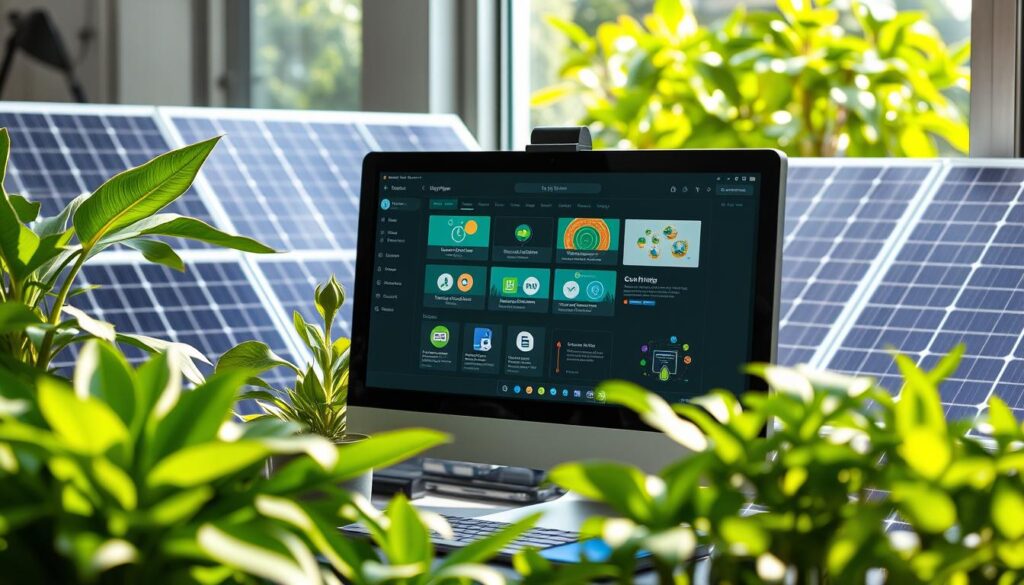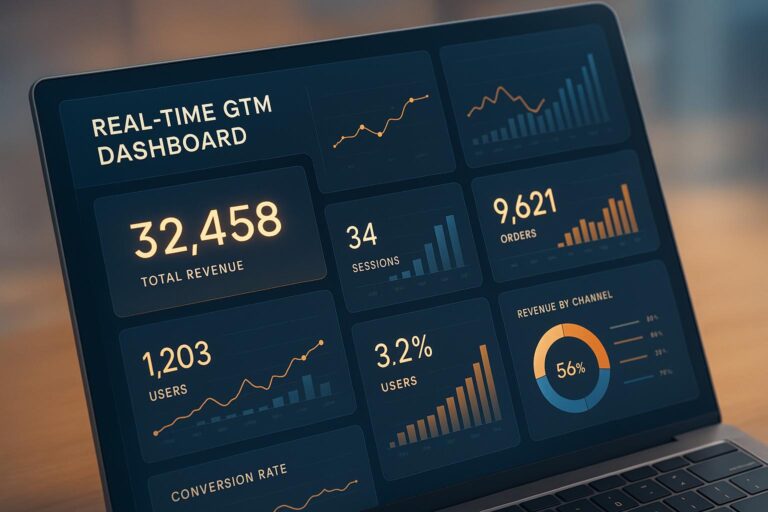As the world faces a worsening climate crisis, the need for eco-friendly software solutions grows. The field of information technology moves fast and innovates constantly. Now, it’s exploring sustainable development. Software developers play a key role in reducing emissions.
The “Greening IT: Need and Opportunities” report shows that software for sustainable goals is crucial. It’s not just an addition but a main strategy against environmental issues. The Green Software Foundation emphasizes optimizing software for energy use. This move towards energy-efficient software creates new opportunities for innovation.
Key Takeaways
- Incorporating energy-efficient algorithms and practices in software can greatly reduce energy use and environmental impact.
- Cloud and virtualization technologies underscore the need to curtail wastage by optimizing resource allocation.
- Benefits of open-source software resonate with the sustainable ethos by encouraging communal innovation and cost-effectiveness.
- Advanced AI and ML applications in software development can boost sustainability through predictive optimization techniques.
- Features that monitor and manage applications’ carbon footprint are pivotal in diminishing the eco-impact of technology.
- Investment in training resources is vital to propagate a culture of sustainability within software development teams.
- Choosing more resource-efficient programming languages can inherently improve a software’s environmental footprint.
The Importance of Sustainable Development in Tech
As technology rapidly advances, it’s vital to focus on sustainability. This helps reduce environmental harm and supports global health. By using sustainable development software solutions, companies in tech can be eco-friendly and economically sound.
Defining Sustainable Development
Sustainability software solutions in tech aim for top eco-efficiency, smart use of resources, and small carbon footprints. They go beyond making IT green. They use digital growth to encourage caring for the environment. Sustainable software development rests on three pillars: economic, social, and environmental. These guide the tech world to act more responsibly.
The Role of Technology in Sustainability
Technology is key in growing sustainably. It creates innovations that cut resource waste and boost efficiency. Tools for high-efficiency energy and smart waste handling change old ways of doing things. Plus, sustainable development tools make renewable energy more reachable and cheaper.
Technology also helps communities manage resources well. It makes sure efforts to save the planet are fair for everyone, no matter their background. The use of sustainability software solutions meets current environmental goals and plans for a lasting green future. Constantly improving these technologies is crucial for a world where tech progress and environmental care go hand in hand.
Key Software Solutions Driving Sustainability
In today’s world, environmental software solutions are key for making businesses more sustainable. They ensure companies comply with environmental laws. More so, they increase efficiency and promote sustainability in various operations. This section covers two important areas: Environmental Management Systems (EMS) and Sustainable Supply Chain Management (SSCM). These are crucial for using software solutions for sustainable growth.
Environmental Management Systems
EMS are at the heart of software solutions for sustainable development. They help organizations track and improve their impact on the planet. EMS manages everything from using resources wisely to reducing waste and emissions. They are essential for companies aiming to be more eco-friendly. For example, cloud computing in EMS saves energy. It cuts down on the need for physical storage and is greener.
Sustainable Supply Chain Management
SSCM changes how products are made and delivered. It aims to reduce harm to the environment and improve social responsibility. A study by McKinsey & Company found that SSCM could cut greenhouse gas emissions by up to 13%. At the same time, it can lower supply chain costs by about 9%. This shows SSCM’s big role in environmental software solutions. SSCM uses tools like IoT to make delivery routes more efficient. It also employs digital certification to lessen the need for resource-heavy methods.
Using these advanced software solutions helps businesses run better and be more eco-friendly. These technologies allow companies to make big changes. They can greatly reduce their harm to the environment. This leads to more sustainable growth in the long term.
Leading Companies and Their Innovations
Business innovation and sustainability goals are now very important in the tech world. Companies like Salesforce and IBM are leading with sustainable technology solutions in their business plans. This shows how important software solutions for sustainable development are.
Salesforce’s Sustainability Cloud
Salesforce uses its cloud platform to help organizations reduce their environmental impact. The Sustainability Cloud lets companies track and report their carbon footprint easily. This makes it possible for businesses to make smarter, greener choices, aiming to lower carbon emissions and use resources better.
IBM’s Green Horizon Initiative
IBM’s Green Horizon Initiative uses AI and analytics to improve environmental management. It aims to predict and manage air quality in cities facing pollution. With detailed insights and predictive analytics, IBM enables smarter decisions for conservation and better environmental quality.
These companies are great examples of merging software solutions with sustainability efforts. Their work with technology is helping to create a healthier planet. Check out their innovative approaches here.
| Company | Initiative | Focus Area |
|---|---|---|
| Salesforce | Sustainability Cloud | Carbon footprint management |
| IBM | Green Horizon | Air quality analytics |
Integrating Sustainability into Software Development
The tech industry is seeing a bigger need for sustainable methods. Agile methods, green coding, and software solutions for sustainable development are changing the way software is built. They keep the environment in mind. Let’s look at how to include sustainability in the software developing steps.

Best Practices for Eco-friendly Software Design
To design eco-friendly software, think about sustainability at every stage. You can use different strategies for this. Some of them include:
- Incorporating agile methodologies: These methods make the software process efficient and less wasteful. This supports sustainability.
- Utilizing green coding techniques: By making code more energy-efficient, we reduce the need for hardware and cut down on carbon emissions.
- Applying frameworks that mix Ecology, Economy, and Social dimensions with software: These frameworks match environmental, economic, and social goals with different types of software development.
The Green Software Foundation says more people are using these eco-friendly approaches. They prefer lasting benefits over immediate profits.
The Importance of User Engagement
It’s key to get users involved in sustainable practices through software. Software that focuses on the user includes features that promote sustainability. This naturally makes users more eco-friendly. For example, Autodesk’s Revit and SolidWorks Sustainability give insights into energy use and eco-impact. This helps users choose greener options.
To truly blend sustainability with software development, the industry must keep evolving. It should keep embracing new sustainable development solutions, green coding, and agile methods. This approach will lead to greener software. It will also make sustainability a normal part of making software.
Measuring the Impact of Software on Sustainability
The impact of the digital world on our planet has become clearer with sustainability software solutions. With these tools, companies can accurately track and boost their carbon efficiency. They also help improve the overall sustainability in software operations.
Key Performance Indicators (KPIs)
Specific KPIs meant for sustainability let organizations measure their eco-friendly progress accurately. They consider various factors like carbon efficiency, energy, and resource use. Good KPIs are essential for making operations more environmentally friendly.
Tools for Assessing Environmental Impact
Recent tools in sustainable development offer advanced analytics on energy use and carbon emissions. For example, platforms like Microsoft’s Carbon Optimization Service give detailed emission data. They also provide tips for lowering your environmental impact.
These tools do more than just monitor; they help companies make meaningful eco-friendly changes. They enable businesses to see exactly how their operations affect the planet. Then, companies can plan better strategies to lessen their footprint.
| Feature | Benefit |
|---|---|
| Cloud sustainability calculators | Provide real-time data on energy consumption |
| Carbon Optimization APIs | Enable detailed tracking and reporting of emissions per resource |
| Software Carbon Intensity formula | Deliver metrics for assessing software-related emissions |
| HTTP caching & CDNs | Reduce data transfer needs and associated energy use |
By using sustainability software solutions, firms do more than follow laws. They move closer to their sustainable development aims. The ability to closely watch and tweak software’s environmental effect is crucial. It helps businesses around the world be more sustainable and responsible.
Challenges in Implementing Sustainable Software Solutions
The push for green technology solutions in software faces many challenges. Organizations must deal with issues like change resistance and managing costs. These need smart handling to encourage the adoption of eco-friendly software solutions.
Overcoming Resistance to Change
Bringing in sustainable development software solutions changes how things are done. It can meet resistance from developers and executives alike. By showing the long-term benefits, such as energy savings and better reputation, we can overcome these hurdles.
Managing Costs vs. Benefits
The main argument against green technology solutions is the upfront cost. Yet, looking ahead reveals savings and operational improvements. Data, like Berkeley’s study on cloud migrations, helps make this case.

Moreover, embracing sustainable software applications helps companies meet global sustainability regulations. This can save on future legal and compliance expenses.
| Aspect | Challenges | Strategic Responses |
|---|---|---|
| Initial Costs | High upfront investment in new technologies and training | Illustrate ROI with long-term savings on energy and operational efficiencies |
| Cultural Resistance | Adherence to traditional practices and technologies | Implement comprehensive training programs and highlight successful case studies |
| Regulatory Compliance | Adapting to fast-changing environmental regulations | Regular updates and compliance audits; Engage in policy advocacy |
In conclusion, the journey toward eco-friendly software solutions has its challenges. Nevertheless, with the right strategies and dedication, companies can gain a lot while helping the environment.
The Future of Software Solutions for Sustainable Development
The path for software solutions for sustainable development is climbing. We can expect big improvements in sustainable technology solutions. Digital energy use is soaring, making it vital to design software wisely. Global digital energy grows nearly 9% each year. This increase is driven by cloud computing, the Internet of Things (IoT), and widespread digital services. Hence, focusing on creating energy-efficient and environmentally friendly software is essential.
Emerging Technologies and Trends
The IT sector’s carbon footprint is becoming a big issue. It could match the aviation industry’s emissions by 2040. Energy-efficient mobile apps, smart home systems, and cloud-based apps can boost business efficiency and cut costs. Adopting sustainable software helps reduce the IT industry’s ecological impact. It aims to support software for sustainable goals.
These steps also improve customer satisfaction. They attract eco-conscious clients and talented workers. As a result, companies are seen as sustainability leaders.
The Role of Policy and Regulation
Regulations for green tech are evolving. Policies now encourage IT firms to be eco-friendlier. This strengthens the role of ESG (Environmental, Social, and Governance) standards. ESG values environmental responsibility. As sustainable software engineering grows, following these practices becomes key for firms. Companies that lower their software’s impact do better in ESG. They also meet the increasing demand for sustainable development. For tips on boosting operational efficiency through software, visit this resource.
FAQ
What are eco-friendly software solutions?
Eco-friendly software solutions aim for environmental sustainability. They might have features that lower carbon emissions, improve energy efficiency, and support sustainable business practices. These solutions help achieve sustainability goals within the tech industry, contributing to the overall green technology effort.
Why is sustainable development important in technology?
The tech sector has a big impact on global emissions. By focusing on sustainability, tech firms can cut their environmental footprint and boost energy efficiency. They also build a culture of responsibility. Thus, sustainable tech solutions are vital for the planet’s future.
How do environmental management systems drive sustainability?
Environmental Management Systems (EMS) guide companies in reducing their environmental impact. These systems use software to set and meet sustainability goals, comply with laws, and boost environmental performance. EMS is key in making development more sustainable.
What is Salesforce’s Sustainability Cloud?
Salesforce’s Sustainability Cloud lets businesses see their environmental impact clearly. It offers tools for tracking, analyzing, and reporting on carbon emissions. This helps companies strategize on how to cut down their emissions effectively.
Why are best practices for eco-friendly software design important?
Best practices in eco-friendly software design prioritize sustainability from the get-go. They focus on using less energy, minimizing waste, and making software last longer. Adopting green coding and agile methods makes software development more sustainable, too.
How are KPIs used to measure the impact of software on sustainability?
Companies use Key Performance Indicators (KPIs) like carbon efficiency and energy use to measure software’s environmental impact. These metrics show how well software meets sustainability targets. Environmental impact tools help tweak software for better sustainability.
What are the challenges of implementing sustainable software solutions?
The roadblocks to sustainable software include high upfront costs, organizational resistance, and proving long-term benefits. Overcoming these hurdles shows that sustainable software can cut costs, streamline operations, and aid in meeting regulatory standards over time.
How will the future of software solutions for sustainable development be shaped?
Future green software will likely benefit from new tech like AI, making sustainability efforts more efficient. Policies and regulations will also guide IT firms towards greener practices. This encourages a market where sustainable solutions become standard.



